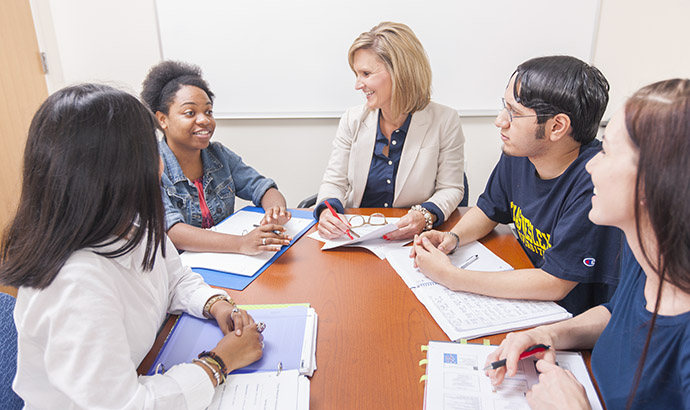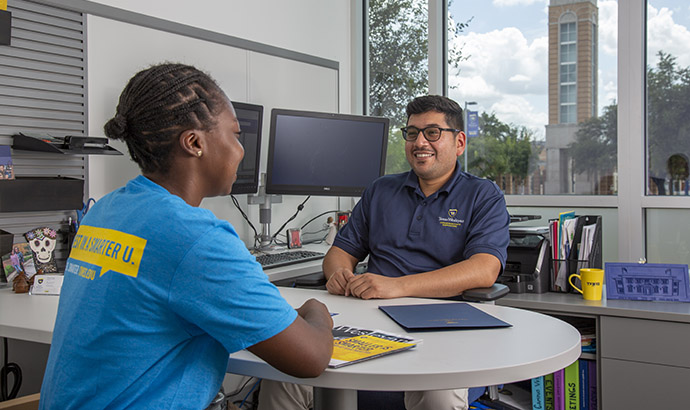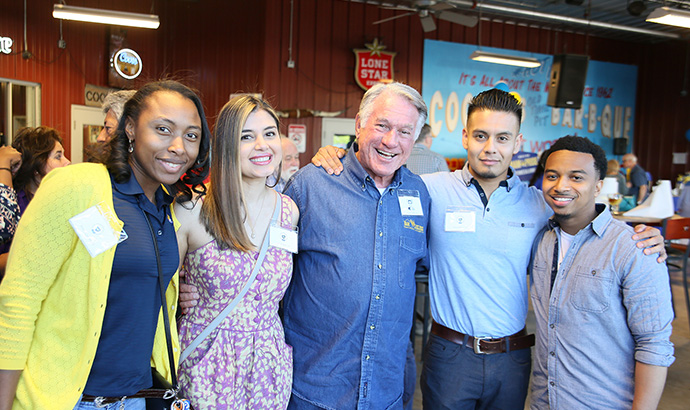Bridging the Gap: Connecting Learning to Teaching
.jpg)
By: Tim Whiting
“Learning results from what the student does and thinks and only from what the student does and thinks. The teacher can advance learning only by influencing what the student does to learn.” -Herbert A Simon
How do we, as educators and instructors, influence a student’s learning process? Let’s connect the principles of learning to fundamental teaching strategies.
Effective Learning Principles
First, we will define learning as “a change in behavior resulting from experience or practice” (Schneider, 2024). This can occur in a number of ways: former education; work experience; trial and error; lectures from our parents.
Let’s start by exploring the concept of learning through the book How Learning Works: 8 Research-Based Principles for Smart Teaching (How Learning Works: The Eight Learning Principles, n.d.). The authors take several approaches to break down the concept of learning. First, they use Mayer’s definition of learning: a process that leads to change, which occurs because of experience and increases the potential for improved performance and future learning (Mayer, 2002). Breaking this down, we see first that learning is a process. It is not an end-product but rather continuous. We also see that it involves a change. This change may be a change in knowledge, beliefs, behaviors, or attitudes. Finally, we can determine that learning is something that students do themselves and that it is not done for them. Therefore, as teachers, we influence them to learn through a lifelong process.
The authors of How Learning Works present eight principles of learning. These principles impact and influence the learning process. For the purpose of this article, we will provide a short synopsis of each.
Individual Differences: Students approach the learning process with what makes them...them. They have intellectual, social, and emotional differences that set them apart and affect how they approach the learning environment. We can see this in the choices that they make and how they communicate with instructors and their peers.
Prior Knowledge: Students bring in a variety of knowledge to the learning situation. This knowledge can be from an academic setting as well as from a social setting. There may be gaps to their knowledge as well as incorrect knowledge.
Knowledge Organization: As the student’s inner computer is processing everything that comes their way, they are sorting it and arranging it. They are looking for relationships and connections to what they already know.
Motivation: The student has goals. They are looking for learning experiences that match those goals. How the learning experience matches their goals determines the level of motivation that they will approach it with.
Skills: As the student is learning, they are asked to learn new skills and perform them to a level of mastery. As they practice the skills, they reach mastery in a variety of ways and in a variety of speeds.
Practice and Feeback: The art of practice creates experiences that are the heart of learning. Without a form of feedback, practice is irrelevant. Feedback is effective when it is strategic, intentional, specific, and consistent.
Course Climate: The learning environment needs to be safe for the student to feel that they can explore, experiment, and evaluate. This includes not only the physical environment but also the social and emotional environment as well. Students thrive when they feel that they belong.
Self-Directed Learner: To take their learning to the next level, students need to know and to apply their metacognitive skills. They need to know how to assess the task at hand, evaluate their own strengths and weaknesses, plan, monitor their performance, and reflect.
(How Learning Works: The Eight Learning Principles, n.d.)
The B.A.S.I.C.S. of Teaching
Now that we have examined the principles of learning, what are our best teaching practices? The B.A.S.I.C.S. of teaching is a concept developed and presented through the webinar Level Up B.A.S.I.C.S. of Teaching and Learning with A.I. (Barragato, A. et al, 2024). Here, we introduce the concept, connect each aspect to the principles of learning, and provide some ideas and teaching strategies that reinforce the learning.
Bringing Learning to Life
Active Learning
Scaffolding Learning
Inclusive Practices
Consistent Assessment
Strategic Feedback
Bringing Learning to Life
Within our teaching, what are we doing to connect the learning to other courses; to the student’s career path; to life outside these four walls? As students see the connect to the real world and see the relevancy, recall increases (Heddy, Sinatra, Seli, Taasoobshirazi, & Mukhopadhyay, 2017) and motivation increases (Smith, 2016).
How does this connect to learning?
- Recognition of individual differences
- Application and connection to prior knowledge
- Impact on motivation
- Opportunity to reach mastery with practice and authentic feedback
- Opportunity to become a self-directed learner
What does it look like within the course?
- Making current/pop culture references
- Having students connect discussion and reflection topics to their career path
- Bring in speakers/experts in the field
- Incorporate service learning
Active Learning
How are the students interacting directly with the learning process? Actively participating in the learning process includes actively thinking about the content, practicing the skills, and hands on interaction. For meaningful learning to occur, students must participate in deliberate, targeted practice (Freeman et al., 2014; Koedinger et al., 2015).
How does this connect to learning?
- Use of individual differences
- Use of prior knowledge
- Referring back to knowledge organization
- Opportunity to reach mastery with practice and feedback
- Opportunity to become a self-directed learner
What does it look like within the course?
- Assign learning activities & assessments that require practicing new knowledge & skills.
- Structuring activities for students
- Insert questioning/discussion into lectures
- Annotating text (Perusall)
- Concept Maps, Case Studies, Polling, Debates, Peer Review
- Students post their own test questions/ answers
Scaffolding Learning
As facilitators of the learning process, we must recognize when too much is too much. By creating steps within the process through scaffolding, we help to create connections, tying ideas together and improving content retention (O’Reilly, Wang, & Sabatini, 2019).
How does this connect to learning?
- Applying prior knowledge
- Aides in knowledge organization
- Creates steps toward mastery
- Opportunity to reach mastery with practice and feedback
- Leads to becoming a self-directed learner
What does it look like within the course?
- Identify students prior knowledge of the content (pre-assessment)
- Break up complex learning into smaller chunks and tasks
- Break up projects into tasks and checkpoints
- Group students together to work on tasks and support each other
Inclusive Practices
As we realize that learning is not just cognitive but also affected by social and emotional experiences (Cavanagh, 2016; Immordino-Yang, 2016), what are we doing to recognize and utilize what each student brings to the table?
How does this connect to learning?
- Support individual differences
- Recognizes prior knowledge and experiences
- Increases motivation
- Created a positive course climate
- Encourages learners to be self-directed
What does it look like within the course?
- Arrive 5-10 minutes early to connect to students
- Getting to Know You Discussion (and response)
- Ice-breaker/ warm-ups
- Assign student roles to encourage participation
- Include tools built on goal setting, organization, reflection, and evaluation
Consistent Assessment
To fully experience the learning at a high level, we must provide our students with time to practice in a safe space with effective feedback. This is done through assessment and not just a 50-question multiple choice exam at the end of the semester but rather in small doses throughout the process.
How does this connect to learning?
- Reinforces and corrects prior knowledge
- Adds to knowledge organization
- Opportunity to reach mastery with practice and feedback
- Leads to becoming a self-directed learner
What does it look like within the course?
- Both formal and informal (exit ticket, discussion)
- Providing multiple attempts for “low to no” stakes practice quizzes.
- Creating unique case studies that students can use to check their understanding.
Strategic Feedback
Learning is not only impacted by specific, targeted feedback in both successes and improvements (Hattie & Timperlay, 2007), but it is also impacted by peer feedback, leading to improvements in self efficacy (Bürgermeister, Glogger- Frey, Saalbach, 2021).
How does this connect to learning?
- Recognizes individual differences
- Reinforces and corrects prior knowledge
- Adds to knowledge organization
- Opportunity to reach mastery with practice and feedback
- Leads to becoming a self-directed learner
What does it look like within the course?
- Providing clear project expectations with guiding questions
- Specific/detailed feedback in a timely manner.
- Direct feedback (video, in person)
- Peer review (teach what that looks like)
- Rubrics (and how to learn from them)
Support
Would you like support in using these strategies in your course and in your teaching? CETL can help. Reach out to set up a consultation. cetl@txwes.edu
References
Barragato, A., Darby, F., and Orr, S. (2024, Oct. 30). “c.” [Webinar]. Cengage Empowered Educator: Peer-to-Peer Professional Development
Bürgermeister, A., Glogger-Frey, I., and Saalbach, H. "Supporting Peer Feedback on Learning Strategies: Effects on Self-Efficacy and Feedback Quality." *Psychology Learning & Teaching*, vol. 20, no. 3, 2021, pp. 383-404. https://doi.org/10.1177/14757257211016604.
Cavanagh, Sarah Rose. *The Spark of Learning: Energizing the College Classroom with the Science of Emotion*. University of West Virginia Press, 2016.
Freeman, S. et al. "Active Learning Increases Student Performance in Science, Engineering, and Mathematics." *Proceedings of the National Academy of Sciences*, vol 111, no. 23, 2014, pp. 8410-8415. https://doi.org/10.1073/pnas.1319030111.
Hattie, J., and Timperley, H. "The Power of Feedback." *Review of Educational Research*, vol. 77, no. 1, 2007, pp. 81-112. https://doi.org/10.3102/003465430298487.
Heddy, B. C., et al. "Making Learning Meaningful: Facilitating Interest Development and Transfer in At-Risk College Students." Educational Psychology, vol. 37, no. 5, 2017, pp. 565-581, doi:10.1080/01443410.2016.1150420.
Koedinger, K. R., et al. "Learning is Not a Spectator Sport: Doing is Better than Watching for Learning From a MOOC." *Proceedings of the Second (2015) ACM Conference on Learning@ Scale, 2015, pp. 111-120. https://doi.org/10.1145/2724660.2724681.
Lovett, Marsha C. et al. How Learning Works: 8 Research-Based Principles for Smart Teaching. Jossey-Bass, 2023.
Mayer, R. E. (2002). The Promise of Educational Psychology: Teaching for Meaningful Learning (Vol. 2). Prentice Hall.
O’Reilly, T., Wang, Z., and Sabatini, J. "How Much Knowledge Is Too Little? When a Lack of Knowledge Becomes a Barrier to Comprehension." *Psychological Science*, vol. 30, no. 9, 2019, pp. 1344-1351. https://doi.org/10.1177/0956797619862276.
Schneider, K. (2024). What is learning? Psychology, 15(05), 779–799. https://doi.org/10.4236/psych.2024.155047
Smith, S. "(Re)Counting Meaningful Learning Experiences: Using Student-Created Reflective Videos to Make Invisible Learning Visible During PjBL Experiences." Interdisciplinary Journal of Problem-Based Learning, vol. 10, no. 1, 2016, https://doi.org/10.7771/1541-5015.1541.







